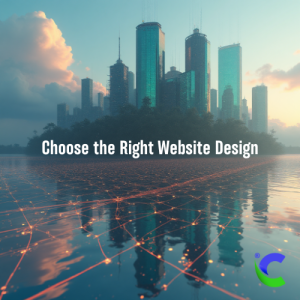Let me tell you a story, one I’ve witnessed unfold countless times. It’s a tale of ambition, innovation, and the digital frontier. Picture this: a small business owner, brimming with passion, ready to conquer their market. They have a brilliant idea, a fantastic product, or a service that’s second to none. But here’s the catch: their website, the very portal to their potential customers, is… well, let’s just say it’s not up to par. Statistics show that a staggering 70% of small businesses falter due to ineffective or poorly designed websites. It’s a harsh reality, and one that I’ve seen firsthand. The digital landscape is littered with the remains of promising ventures that simply couldn’t navigate the treacherous waters of online presence. This is why the journey to choose the right website design company is so critical. It’s not merely a business decision; it’s an investment in your future, a commitment to your vision, and a declaration to the world that you’re ready to play in the big leagues. I’ve acted as a guide, a digital sherpa if you will, assisting numerous companies in their quest to select a website design partner who truly understands their core values and objectives. It goes beyond aesthetics; it requires finding a team that intimately understands your business and can translate that knowledge into a captivating online experience that captures the attention of visitors and keeps them engaged. Consider this your initial stride towards making a well-informed choice. So, how do you avoid becoming another statistic? How do you ensure that your website becomes a powerful engine for growth, rather than an anchor dragging you down? The answer lies in a strategic, step-by-step approach to selecting the right partner for your digital journey.
Step 1: Define Your Website’s Purpose
Before you even think about searching online, take a moment to clearly define what you want your website to accomplish. What are your core business objectives? What kind of impression do you want visitors to have? What are the absolute must-have functionalities of the site? Ask yourself these crucial questions:
- Lead Generation, Sales, or Information?: Will this website be a magnet for new leads, a platform for selling products, or simply a digital brochure providing information?
- Ideal Customer Profile: Who is your ideal customer? What are their demographics, interests, and online behaviors?
- Brand Identity: What are the fundamental principles of your brand, and how can you effectively communicate them through your website?
- Functionality: Are you planning to incorporate e-commerce capabilities, a blog for thought leadership, or other advanced features?
- Budget Allocation: How much are you prepared to invest in this website design project?
Having clear and concise answers to these questions will help you filter through the noise and accurately communicate your needs to potential design firms. A clearly defined scope will save you time, money, and frustration in the long run.
Step 2: Locate Local Web Design Experts
Begin your search locally. There’s undeniable value in collaborating with professionals you can meet face-to-face. Use search engines like Google or Bing to find website design firms in your immediate vicinity. Look for evidence of successful projects and positive client testimonials.
Try these search queries:
- “Website design company near me”
- “Web design agency [your city]”
- “Top website designers in [your area]”
Don’t simply choose the first company you find. Take the time to explore the options and bookmark any firms that pique your interest. Consider also searching for more specific keywords, like “Shopify website design” if that is your platform of choice, or “WordPress website design” if you prefer that content management system.
Step 3: Scrutinize Portfolios
A design firm’s portfolio serves as its professional resume. Carefully examine firms that have created websites in your industry or that exhibit a design style that resonates with you. Consider these critical factors:
- Design Excellence: Is the design sleek, modern, and user-friendly?
- Functional Performance: Does the site operate smoothly and efficiently?
- Mobile Optimization: Does it display flawlessly on smartphones, tablets, and desktop computers?
- Industry Specialization: Do they possess experience in your specific industry?
Case studies offer valuable insights into a firm’s problem-solving abilities and their capacity to deliver exceptional results. Look for case studies that demonstrate a deep understanding of the client’s needs and a successful execution of the project.
Step 4: Analyze Client Feedback
Client reviews provide a glimpse into a design firm’s reputation. Explore platforms such as Google, Yelp, and Clutch to identify patterns in customer feedback. Do clients consistently praise their communication skills, design quality, or project management capabilities? Are there any recurring complaints or red flags?
Pay close attention to negative reviews and, more importantly, the firm’s response. A thoughtful and professional response demonstrates their commitment to client satisfaction and their ability to resolve issues effectively. Look at the recent reviews, as a company can go through many changes over time.
Step 5: Interrogate Their Process
Understanding a design firm’s operational procedures is essential. A well-defined process ensures a seamless project and keeps you informed every step of the way. Inquire about their process, including:
- Discovery Phase: How do they delve into the intricacies of your business?
- Design Phase: How many design concepts do they present? How many revisions are permitted?
- Development Phase: What technologies do they utilize? Are they proficient in coding?
- Testing Phase: How do they thoroughly test the website to ensure optimal functionality?
- Launch Phase: How do they deploy the website and make it accessible to the public?
- Post-Launch Support: What kind of support do they provide after the website is launched?
A reputable firm will clearly articulate its process and address all your inquiries comprehensively.
Step 6: Evaluate Their Skill Set
Website design encompasses a wide range of skills. Ensure that the firm you choose the right website design company from possesses the necessary expertise. Consider these areas:
- Web Design: Do they have a strong understanding of design principles, user experience, and visual storytelling?
- Web Development: Are they proficient in coding languages such as HTML, CSS, JavaScript, and PHP?
- SEO (Search Engine Optimization): Do they understand how to optimize your website for search engines?
- Content Creation: Can they create engaging and persuasive content?
- Digital Marketing: Can they assist you in promoting your website effectively?
Some firms specialize in specific areas such as e-commerce or custom web applications. Ensure that their skills align with your specific requirements.
Step 7: Meet Face-to-Face and Ask the Important Questions
Once you’ve narrowed down your choices, schedule meetings to discuss the details. This is your opportunity to meet the team and assess whether you have good chemistry.
Consider asking these questions:
- What is your experience in my industry?
- Can I see examples of websites you’ve created for similar businesses?
- What is your design philosophy?
- How do you manage projects and maintain open communication?
- What is your pricing structure?
- What payment options do you offer?
- What is the estimated timeline for this project?
- What kind of post-launch support can I expect?
Pay attention to their responses. Are they helpful, clear, and concise? Do they seem genuinely enthusiastic about your project?
Step 8: Discuss Budget and Payment
Website design costs can vary significantly depending on the project’s complexity and the firm’s experience. Obtain a clear understanding of the costs and payment options upfront. Request a detailed proposal that covers all aspects of the project.
Be wary of extremely low prices, as they often indicate poor quality or inexperience. However, don’t assume that the most expensive firm is necessarily the best. Carefully compare proposals and consider the value you’re receiving for your investment.
Inquire about payment schedules. Most firms require a deposit, with the final payment due upon completion of the project. Some may offer payment plans to make the investment more manageable.
Step 9: Check References
If you’re seriously considering a firm, request references from previous clients. Contact these individuals and inquire about their experience. Were they satisfied with the project management, communication, and design quality? Did they encounter any challenges along the way?
Also, verify the firm’s credentials. Are they members of any professional organizations or do they hold any relevant certifications?
Step 10: Make Your Choice and Sign the Agreement
After carefully evaluating all the information, it’s time to make a decision. Choose the right website design company that aligns with your goals, needs, and budget.
Before commencing the project, ensure that you have a contract that outlines the scope of work, timeline, payment terms, and all other essential details. Read it carefully and ensure that you understand everything. Don’t hesitate to ask questions or negotiate any terms that make you uncomfortable.
A well-written contract protects both parties and sets the stage for a successful partnership.
Step 11: Maintain Open Communication
Throughout the project, maintain clear and consistent communication. Provide regular feedback and address any concerns promptly. A collaborative approach ensures that the final product meets your expectations.
Establish clear communication channels and response time expectations. Regular updates will keep you informed and engaged.
Conclusion
Selecting a website design partner requires careful consideration and a structured approach. By following these steps, you’ll significantly increase your chances of finding a firm that aligns with your vision and delivers a website that effectively represents your brand. This, in turn, will create the online presence you need to achieve your business objectives and thrive in the digital age.

